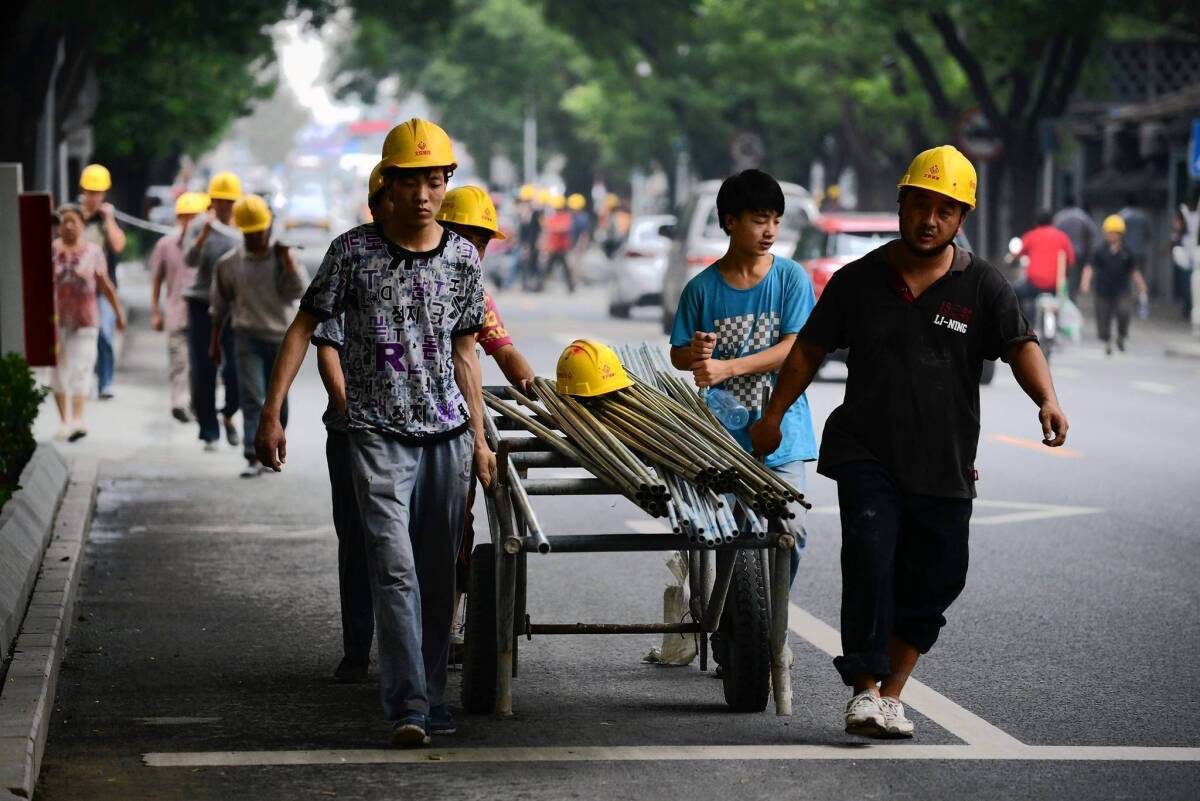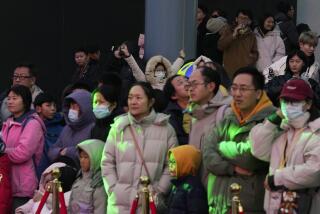China economic growth slows, partly on purpose

BEIJING — China’s economy is slowing fast. And that may be a very good thing.
Falling exports and tighter credit cooled China’s growth in the second quarter to 7.5% from a year earlier, officials said Monday. Growth in the first quarter was 7.7% and many analysts now predict the nation’s gross domestic product will expand 7.5% — or even less — for the year.
Although that’s a blistering pace compared with those of the U.S. and many other Western nations, it would be a drop from China’s 7.8% rate last year and the country’s slowest growth since 1990 after nearly two decades of double-digit annual expansion.
Although some of the deceleration is linked to global economic factors — such as continued weakness in Europe and the prospect of tighter monetary policy in the U.S. — a portion seems to be the result of deliberate policy choices by the new Chinese leaders who took office in the spring.
In the wake of the 2008 global financial crisis, Chinese authorities unleashed a flood of stimulus to keep the economy going while the rest of the world slowed, and they kept the spigots on until this year. But much of the cheap money ended up circulating in financial markets or being plowed into real estate ventures and infrastructure projects rather than being used to expand and improve businesses.
Now, with concerns about bad loans mounting and growth slowing, new President Xi Jinping, Prime Minister Li Keqiang and other top officials are signaling it’s time to shift gears. They want to cut off stimulus, reduce debt and press new policies to reform and open the economy (one bank has branded the strategy “Likonomics,” after Li, who is in charge of economic policy).
Just how much control Li and his cohorts actually have over the situation remains to be seen. But they say they are willing to sacrifice rapid GDP expansion for higher-quality, stable growth that moves the nation up the value chain and creates better jobs with higher salaries.
“China is facing a period of creative destruction. The creativity part of that is real … and will ultimately be good in terms of redirecting resources in ways that are much more productive,” said Patrick Chovanec, chief strategist for Silvercrest Asset Management and a longtime China watcher.
“But the destruction part is real too,” he said. “So you’re going to have sectors that have driven growth over the last several years but now there’s massive overinvestment and massive overcapacity. They may actually see significant contraction. Steel, shipbuilding, construction — these are key areas where we already start to see this happening.”
Reining in credit will squeeze banks and borrowers, including real estate developers, local governments and heavy manufacturers. But last week, Finance Minister Lou Jiwei said officials intend to stick to their path even if creates some short-term problems, and he dismissed the idea of expanding the budget deficit to stimulate the economy.
“It won’t be possible to enjoy a comfortable life and rapid growth with the structural adjustment,” he said, calling it a “painful process.”
Michael Pettis, a finance professor at Peking University, thinks Chinese growth rates will bottom out at 3% or 4%. “So far,” he said, “the good news is that they’ve demonstrated they’re willing to tolerate more of a slowdown than I would have expected.”
Broadly speaking, any nation’s GDP can be broken down into four basic categories of activity: net exports, government spending, business investment and consumer spending. In the U.S., about 70% of GDP is the result of consumer spending; in China, it’s about half that. Business investment is the biggest share in China, about 50%.
To put China on a more stable footing, the government’s economic policymakers and many outside analysts believe, the nation needs to increase consumer spending and reduce investment. Retail sales rose 13.3% in June compared with a year earlier.
“The question now is: How fast will they go about this rebalancing?” Pettis said. “You can adjust quickly — that’s more economically efficient — but it can be more socially difficult.”
With trade weak — China’s exports fell 3.1% in June compared with a year earlier — there may be further downward pressure on growth, and that could lead to problems such as rising unemployment.
Sluggish trade, however, could have an upside: It could prompt new measures to let the market play a bigger role in the economy and introduce competition in sectors dominated by lumbering state-owned enterprises.
In the short run, officials have announced they’re trimming spending at some government agencies by 5% and might use the proceeds to cut taxes. That would be one way to boost household incomes and spending. Officials are also looking at ways to quickly direct more fiscal support to small and medium-sized businesses that are seen as better engines of growth.
China’s economic policymakers are now hammering out longer-term priorities that are due to be unveiled at a key Communist Party gathering in October.
Analysts say China’s leaders have a broad range of possible reforms, though each comes with risks and political obstacles. Baizhu Chen, a finance professor at USC’s Marshall School of Business, said authorities could consider such policy changes as deregulating service industries to create more competition, accelerating rural land reform and opening up the financial sector to greater foreign competition.
With the nation’s population rapidly aging, Chen said, Chinese officials might even consider whether it’s time to end the one-child policy, which has been in effect since the late 1970s.
“It’s a debatable issue now,” Chen said. “Before, it was not even a debatable issue. But personally I think this is possible in five or 10 years and it would have a big impact down the road.”
How China’s slowdown will affect the rest of the world largely depends on where you sit. Although a slowdown in lending could stress banks and result in some corporate defaults, analysts say China’s financial system remains sufficiently isolated that such incidents would be relatively contained.
But countries such as Australia and Chile, which have benefited from China’s investment boom by selling raw materials like iron ore and copper, may be hit hard, Silvercrest’s Chovanec said.
For the U.S., the picture is less simple. Some companies, such as construction equipment maker Caterpillar, have been feeding China’s investment boom and are highly vulnerable in a slowdown.
“But there are others like Wal-Mart … or General Motors where it’s a little bit more complicated story. It’s much more of a China consumer play over time,” Chovanec said. “This could benefit them.”
In general, Chen said he believes China’s leaders are “on the right track.”
“But the risks are high, and I don’t think it will be very smooth. There will be two steps forward and one step back.”
More to Read
Start your day right
Sign up for Essential California for news, features and recommendations from the L.A. Times and beyond in your inbox six days a week.
You may occasionally receive promotional content from the Los Angeles Times.







